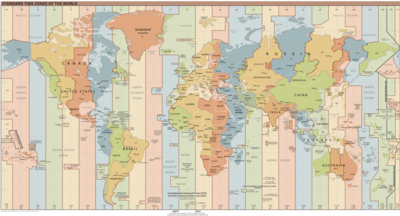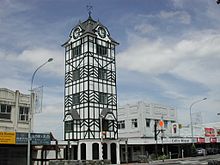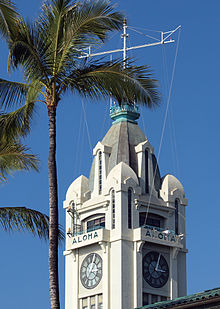
This is a list of countries, regions, and territories grouped by time zone.
Although many time zones have descriptive names used by people in them, they are least ambiguously identified by their relationship to UTC (Universal Time, Co-ordinated). UTC used to be called GMT (Greenwich Mean Time), after the Royal Observatory located in the Greenwich area of London.
UTC is also sometimes called Z or Zulu time. A time may be written as e.g. 21:45Z with the Z indicating UTC. The "Z" is for "zero", and "Zulu" is the two-way radio pronunciation of "Z". It comes from the nautical system in which each time zone was assigned a letter.
Time zones east of UTC and west of the International Date Line are specified by the number of hours ahead of UTC (e.g. UTC+4); zones west of UTC and east of the Date Line are specified by the number of hours behind UTC (e.g. UTC-6). Crossing the Date Line going eastward, clocks are turned back a full 24 hours, and vice versa in the opposite direction. (Note: The total span of time zones covers more than 24 hours because the Date Line jogs westward and eastward to keep certain national island groupings on the same calendar day, although they are not within a single time zone.)
Travel across time zones
You need to take some care when planning trips that cross several time zones, e.g.,:
- Your "body clock" may experience some stress as you "tell" it to meet business appointments, tours and other obligations perhaps a few or several hours different from the hours you normally rest.
- You may miss an important obligation, or connections with scheduled transport, simply by not understanding what will be the correct local time as you travel.
- Crossing the International Date Line can cause confusion about on what date you'll arrive, e.g.,:
- Starting a 12–15 hour flight from the U.S. west coast to Japan or Hong Kong in late evening can land you there in the morning two calendar days later.
- If starting the reverse course by midday, you may in a way "travel back in time" as you land earlier than you started. For example a typical flight from Sydney to LA will take off at lunchtime and land early in the morning on the same calendar date!
If your travel has time zone complexities or possible impacts on your health or comfort, consult an expert as you plan it.
Jet lag
- See also: Jet lag
Jet lag is a mismatch between your body clock and the local time wherever you are. It's caused by rapid travel across time zones, and compounded by the fact that long hours spent on a plane can cause you to sleep too much, or not enough, possibly at the wrong time. Flights from east to west, where you gain a few hours, are usually a bit easier, as most people find it easier to stay up a little later than to go to bed earlier. A rule of thumb is that you recover about 1 hour difference per day. You may find that on your way out, you are fine after just a couple of days, but you will really notice the recovery period on your way home. At that point your body clock will be really confused and it will take a while for it to sort things out.
You can aid the process a bit by trying to operate on your new local time as early as possible, and spending the daylight hours first few days in your new time zone outdoors. If you're going to land early in the day, try to sleep on the plane so you arrive refreshed and ready for a full day of activity. Conversely, if you're going to arrive near the evening, try to stay awake on the plane so that you'll be tired when you arrive and can get a lengthy sleep.
Daylight Saving Time
In many jurisdictions, local time is set forward by an extra hour in summer to "shift" daylight hours to the end of the day. This is known in the UK as British Summer Time (BST, GMT+1) and almost anywhere else as Daylight Saving Time (DST) or (name of local time zone) Daylight Time.
In temperate northern countries, DST usually starts late March/early April and ends late October/early November; exact start dates vary by country. Equatorial nations typically use no DST; southern nations will use dates that match their local summer. It's not unheard of for an individual province or state — or even a piece of one province — to opt out of a DST scheme in effect in the rest of the same nation. Due to the nature of daylight savings time the difference in time zones may vary during the year as one country doesn't have daylight savings time while the other does, or both have it but start at different times. However due to increasing commerce and international communication via the internet and other nearly instantaneous modes, there are increasing efforts to harmonize those things, especially among direct neighbors or political entities with good relations with each other.
"Political" time-zones
As can be seen on the map above, some time-zones seem to defy logic and were mostly drawn by national or regional governments to make commerce and administration easier. This can have strange consequences, most notable in the case of China which "should" span three time-zones at least but for political reasons observes the same (Beijing) time in all its territory. Departure times of long distance transport (most notably the Transsiberian railway) are also often given in one time only (usually that of the departure point) and it was in fact the railway that made time zones necessary in the first place (instead of thousands of "local times" only minutes apart). Another "odd" time-zone border lies in Europe where (also mostly due to political reasons) going west from France lets you keep in the same time-zone (when you "should" have to change from Central European time to UTC) but going north from France to Britain you will have to change time-zone. Daylight savings time can further complicate this, as most tropical countries see absolutely no need for it and thus keep on standard time year round, which means the difference to other countries makes wild "leaps". As there is no universally agreed point of the year to change from standard to daylight savings time, there may also be "fluctuations" of up to several weeks when one country has already changed and the other hasn't. If you are traveling during that time or calling home, make sure to inform yourself of the local time at both your destination and point of origin.
List of time zones
UTC+14
- Kiribati Line Islands (except U.S. dependencies - see UTC-11)
- Samoa (during Daylight Saving Time)
- New Zealand: Tokelau
UTC+13:45
- New Zealand: Chatham Islands (during Daylight Saving Time)
UTC+13

- Kiribati: Phoenix Islands
- New Zealand (during Daylight Saving Time)
- Samoa
- South Pole (during Daylight Saving Time)
- Tonga
UTC+12:45
UTC+12
- Fiji
- Kiribati: Gilbert Islands
- Marshall Islands
- Nauru
- New Zealand
- Russia: Chukotka, Kamchatka
- South Pole
- Tuvalu
- Wake Island
- Wallis and Futuna
UTC+11:30
UTC+11

- Australia: Australian Capital Territory, New South Wales, Tasmania, Victoria (Australian Eastern Daylight Time)
- Federated States of Micronesia: Kosrae, Pohnpei
- New Caledonia
- Russia: Kuril Islands, Magadan Oblast, Sakha
- Solomon Islands
- Vanuatu
UTC+10:30
- Australia: South Australia (Australian Central Daylight Time)
UTC+10
- Australia: Australian Capital Territory, almost all of New South Wales, Queensland, Tasmania, Victoria (Australian Eastern Standard Time)
- Federated States of Micronesia: Chuuk, Yap
- Guam
- Northern Mariana Islands
- Papua New Guinea
- Russia: Primorsky Krai, Khabarovsk Krai, Yakutia, Sakhalin Island
UTC+9:30
- Australia: Northern Territory, South Australia, Broken Hill (New South Wales) (Australian Central Standard Time)
UTC+9

- East Timor
- Indonesia (eastern): Maluku, Western New Guinea
- Japan
- South Korea
- Palau
- Russia: Amur Oblast, Zabaykalsky Krai, Yakutia
UTC+8:30
UTC+8

- Australia: Western Australia (Australian Western Standard Time)
- Brunei
- China While China "should" geographically be in several time-zones the Central Government has declared Beijing time to be official in all of China even as far west as Tibet. While this makes travel a lot easier, it leads to sunrises at 9 am and other strange things.
- Hong Kong
- Indonesia (central): (Bali, Borneo)
- Macau
- Malaysia
- Mongolia (most of country)
- Philippines
- Singapore
- Taiwan
- Russia: Buryatia, Irkutsk Oblast
UTC+7

- Bangladesh
- Cambodia
- Christmas Island (Australia)
- Indonesia (western): (Java, Sumatra)
- Laos
- Mongolia (Hovd, Uvs, and Bayan-Ölgii)
- Russia: Kemerovo, Khakassia, Krasnoyarsk Krai, Tomsk, Tuva
- Thailand
- Vietnam
UTC+6:30
UTC+6
- Bhutan
- British Indian Ocean Territory (CIA)
- Kazakhstan (Eastern)
- Kyrgyzstan
- Russia: Altai Krai, Altai Republic, Novosibirsk Oblast, Omsk Oblast, Tomsk Oblast
UTC+5:45
UTC+5:30

UTC+5
- British Indian Ocean Territory (NAO)
- French Southern and Antarctic Lands
- Heard Island and McDonald Islands
- Kazakhstan (Western)
- Maldives
- Pakistan
- Russia: Astrakhan, Bashkortostan, Chelyabinsk, Kurgan, Orenburg, Perm, Saratov, Sverdlovsk, Tyumen, Ulyanovsk, Volgograd
- Tajikistan
- Turkmenistan
- Uzbekistan
UTC+4:30
UTC+4

- Armenia
- Azerbaijan
- Georgia
- Mauritius
- Oman
- Réunion
- Russia: most of European portion, including Moscow, Saint Petersburg, Rostov on Don, Novaya Zemlya, Franz Josef Land, and all railroads throughout Russia including Samara, Udmurtia
- Seychelles
- United Arab Emirates
UTC+3:30
UTC+3

- Bahrain
- Comoros
- Djibouti
- Eritrea
- Ethiopia
- Iraq
- Kenya
- Kuwait
- Madagascar
- Mayotte
- Qatar
- Russia: Kaliningrad Oblast
- Saudi Arabia
- Somalia
- Sudan
- Tanzania
- Uganda
- Yemen
UTC+2

- Belarus
- Botswana
- Bulgaria
- Burundi
- Democratic Republic of the Congo (eastern)
- Cyprus
- Egypt
- Estonia
- Finland
- Greece
- Israel
- Jordan
- Latvia
- Lebanon
- Lesotho
- Lithuania
- Malawi
- Moldova
- Mozambique
- Romania
- Russia: Kaliningrad Oblast
- Rwanda
- South Africa
- Swaziland
- Syria
- Turkey
- Ukraine
- Zambia
- Zimbabwe
UTC+1


- Albania
- Andorra
- Algeria
- Angola
- Austria
- Belgium
- Benin
- Bosnia and Herzegovina
- Cameroon
- Central African Republic
- Chad
- Republic of the Congo
- Democratic Republic of the Congo (western)
- Croatia
- Czech Republic
- Denmark
- Equatorial Guinea
- France
- Gabon
- Germany
- Gibraltar
- Hungary
- Italy
- Libya
- Liechtenstein
- Luxembourg
- Republic of Macedonia
- Malta
- Monaco
- Montenegro
- Namibia
- Netherlands
- Niger
- Nigeria
- Norway
- Poland
- San Marino
- Serbia
- Slovakia
- Slovenia
- Spain
- Sweden
- Switzerland
- Tunisia
- Vatican City
UTC


- Burkina Faso
- Bouvet Island
- Canary Islands
- Cote d'Ivoire
- Faroe Islands
- Gambia
- Ghana
- Greenland (northeastern)
- Guernsey
- Guinea
- Guinea-Bissau
- Iceland
- Ireland
- Isle of Man
- Jersey
- Liberia
- Mali
- Mauritania
- Morocco
- Northern Ireland
- Portugal
- Saint Helena
- Senegal
- Sierra Leone
- Sao Tome and Principe
- Togo
- United Kingdom
- Western Sahara
UTC-1
- Azores (Portugal)
- Cape Verde
- Greenland (east)
UTC-2
- Fernando de Noronha (Brazil)
- South Georgia and the South Sandwich Islands
- Trindade and Martim Vaz (uninhabited islands) (Brazil)
UTC-3

- Argentina
- Brazil: Brasilia, Rio, São Paulo, Fortaleza, Maceio, Recife, Salvador etc.
- French Guiana
- Greenland (central)
- Guyana
- Saint Pierre and Miquelon
- Suriname
- Uruguay
UTC-3:30
- Canada: Newfoundland (most of Labrador, except Forteau and Red Bay, is UTC-4)
UTC-4

- Anguilla
- Antigua and Barbuda
- Aruba
- Barbados
- Bermuda
- Bolivia
- Brazil: Boa Vista, Campo Grande, Manaus
- Canada ("Atlantic Time"): Labrador, New Brunswick, Nova Scotia, Prince Edward Island, eastern Quebec
- Chile
- Dominica
- Dominican Republic
- Falkland Islands
- Greenland (west)
- Grenada
- Guadeloupe
- Guyana
- Martinique
- Montserrat
- Netherlands Antilles
- Paraguay
- Puerto Rico
- Saint Kitts and Nevis
- Saint Lucia
- Saint Vincent and the Grenadines
- Trinidad and Tobago
- U.S. Virgin Islands
UTC-4:30
UTC-5

- Bahamas
- Brazil: Acre
- Canada ("Eastern Time"): Nunavut, most of Ontario, most of Quebec
- Cayman Islands
- Colombia
- Cuba
- Ecuador
- Haiti
- Jamaica
- Navassa Island
- Panama
- Peru
- Turks and Caicos Islands
- United States of America ("Eastern Time"): Maine, New Hampshire, Vermont, Massachusetts, Connecticut, Rhode Island, New York, Michigan except extreme northwestern counties, Indiana except the southwest and northwest corners, Ohio, Pennsylvania, New Jersey, eastern Kentucky, West Virginia, Virginia, Washington, D.C., Maryland, Delaware, eastern Tennessee, North Carolina, Georgia, South Carolina, Florida except western part of panhandle.
UTC-6

- Belize
- Canada ("Central Time"): Manitoba, Saskatchewan except for the region around Lloydminster, north-western Ontario. Saskatchewan does not use daylight time, except in Lloydminster.
- Costa Rica
- Easter Island
- El Salvador
- Galapagos Islands
- Guatemala
- Honduras
- Mexico
- Nicaragua
- United States of America ("Central Time"): Wisconsin, Illinois, the southwest and northwest corners of Indiana, western Kentucky, western and middle Tennessee, Mississippi, Alabama, Minnesota, Iowa, Missouri, Arkansas, Louisiana, north and east North Dakota, eastern South Dakota, middle and eastern Nebraska, most of Kansas, Oklahoma, most of Texas, part of western Florida(panhandle).
UTC-7
- Canada ("Mountain Time"): Alberta, small eastern portion of British Columbia, both sides of Lloydminster, which lies on the Alberta–Saskatchewan border
- Mexico: Baja California Sur: Chihuahua, Nayarit, Sinaloa, Sonora. No Daylight Time in Sonora.
- United States ("Mountain Time"): southwest North Dakota, western South Dakota, western Nebraska, a sliver of Kansas, Montana, a sliver of Oregon, southern Idaho, Wyoming, Utah, Colorado, Arizona, New Mexico, a corner of Texas. No Daylight Time in Arizona, except for the Navajo Nation.
UTC-8

- Canada ("Pacific Time"): most of British Columbia, Yukon
- Clipperton Island
- Mexico: Baja California Norte
- Pitcairn Islands
- United States of America ("Pacific Time"): Washington, northern Idaho, most of Oregon, California, Nevada
UTC-9
UTC-9:30
UTC-10

- Cook Islands
- French Polynesia: Society Islands, Tuamotu Islands, Austral Islands
- Johnston Atoll
- Tokelau
- United States of America: Hawaii, and Aleutian Islands in Alaska
